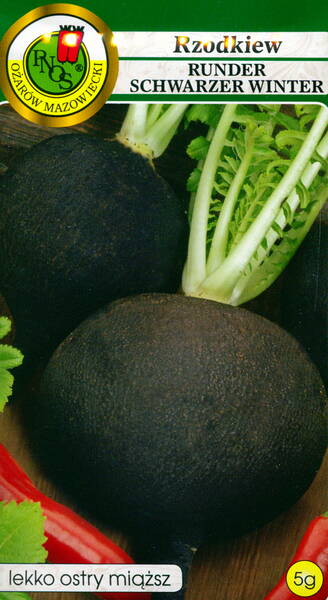Your shopping cart is empty!
Winter radish "Runder Schwarzer Winter"
Black winter radish ''Runder Schwarzer Winter'' - Raphanus sativus var. nigra.
Stored for a long time, keeping juiciness until spring!
A mid-early variety of winter radish: the period from full germination to the beginning of technical ripeness is 68-75 days.
Root crops are black, rounded (8-12 cm), weighing about 250-400 g. The pulp is white, juicy, with an excellent spicy-piquant taste. Good and long-term storage in winter. 1 gram contains 100-130 seeds.
* The radish develops normally and forms good roots only if the "distance" is observed - it should spread the leaves wide and freely and put them on the garden bed, but it is not worth leaving too much space between the radish plants, because then too large roots will turn out to the detriment of their quality. Optimum final distance after thinning: 10-15 cm, depending on the variety.
At the same time, with dense planting, the plants interfere with each other, so their rosettes are forced to stand upright and the radish begins to trunk and grow stiff.
Radish roots sticking out of the soil are constantly sprinkled with earth during their growth - then there will be fewer voids, hardenings and black folds in the pulp.
To obtain a high yield of radish, systematic, abundant watering is necessary to ensure constant soil moisture.
For black radish intended for winter storage, the tops should not be cut off, but unscrewed.
Stored for a long time, keeping juiciness until spring!
A mid-early variety of winter radish: the period from full germination to the beginning of technical ripeness is 68-75 days.
Root crops are black, rounded (8-12 cm), weighing about 250-400 g. The pulp is white, juicy, with an excellent spicy-piquant taste. Good and long-term storage in winter. 1 gram contains 100-130 seeds.
* The radish develops normally and forms good roots only if the "distance" is observed - it should spread the leaves wide and freely and put them on the garden bed, but it is not worth leaving too much space between the radish plants, because then too large roots will turn out to the detriment of their quality. Optimum final distance after thinning: 10-15 cm, depending on the variety.
At the same time, with dense planting, the plants interfere with each other, so their rosettes are forced to stand upright and the radish begins to trunk and grow stiff.
Radish roots sticking out of the soil are constantly sprinkled with earth during their growth - then there will be fewer voids, hardenings and black folds in the pulp.
To obtain a high yield of radish, systematic, abundant watering is necessary to ensure constant soil moisture.
For black radish intended for winter storage, the tops should not be cut off, but unscrewed.
* What is the best time to sow winter radish?
In Estonia, the best time to sow winter radish is the first or second half of June.
Black radish takes a long time to grow, about 90 days, so it is fed twice.
The first time is at the stage of 5-6 leaves (3 tablespoons of azophoska per 10 liters of water, using 1 glass per plant).
The second time is fed at the stage of root crop formation (1 tablespoon of superphosphate, 2 tablespoons of any potassium fertilizer per 10 liters of water, using 1 glass per plant).












